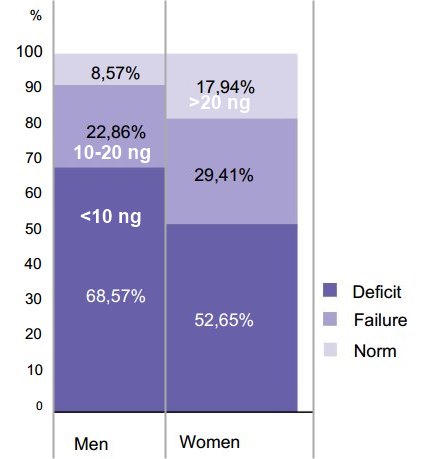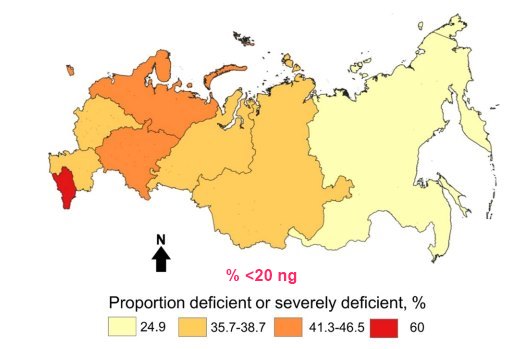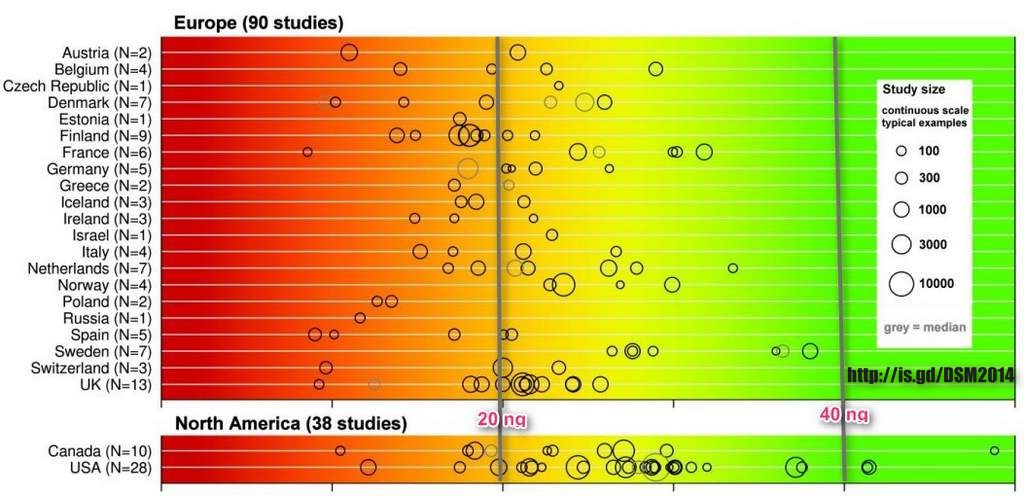Russia and Vitamin D - many studies
Low D for some Russians due to high latitude (llttle UVB get thru so much atmosphere)
Low D due to alcohol
Low D due to smoking (50% to 60% of Russian men smoke)
Low D due to low Magnesium (needed at 8 stages of Vitamin D processing
Low D due to low Omega-3 (very few seafoods)
needed to get Vitamin D from the blood into the cells
9+ VitaminDWiki pages have RUSSIA in the title
This list is automatically updated
{LIST()}
Many childhood chronic health diseases in Russia due to low vitamin D (especially Siberia, 24 ng MAX) – July 2024
MULTICENTER STUDY OF VITAMIN D LEVELS IN CHILDREN WITH CHRONIC DISEASES IN THE RUSSIAN FEDERATION
BMJ Paediatrics Open 2024;8(Suppl 5):A1–A116 poster 10.1136/bmjpo-2024-EPAC.173
1Elena Kondratyeva*, 1 Elena Loshkova, 1 Nuriniso Odinaeva, 1 Elena Zhekaite, 2Natalia Ilyenkova, 3Leonid Klimov, 4Yulia Melyanovskaya, 5Yuri Mizernitsky, 3Svetlana Dolbnya.
1Research Clinical Institute of Childhood of the Ministry of Health of the Moscow Region;
2 V.F. Voino-Yasenetsky Krasnoyarsk State Medical University;
3 Stavropol State Medical University of the Ministry of Health of the Russian Federation;
4 Federal state budgetary scientific institution «Research Centre for Medical Genetics»;
5 NIKI Pediatrics GBOU VPO RNRMU im. N.I. Pirogov Ministry of Health of Russia, Moscow
Aim To assess the frequency of low vitamin D levels and the level of calcidiol in patients with cystic fibrosis (CF), bronchial asthma (BA), juvenile idiopathic arthritis (JIA) in three regions of Russia.
Material and Method A total of 283 patients with CF, 160 with BA, 150 with JIA, and 333 healthy children in the control group were examined in three regions of the Russian Federation (Moscow region, Krasnoyarsk region, Stavropol region).
Results Normal concentration of 25(OH)D was detected in 49.3% of CF, insufficiency in 26.3%, deficiency in 16.7% of children, severe deficiency in 7.7% of patients.
The maximum level of 25(OH)D was detected in the Moscow region (30.7 ng/ml), further in the Krasnoyarsk Territory (27.1 ng/ml), the minimum - in the Stavropol Territory (24.4 ng/ml).
In the general group of patients with asthma, 89.62% had a low supply of vitamin D, severe deficiency 23.71%, deficiency 46.66%, insufficiency 19.25%.
An analysis of the supply of vitamin D depending on the region of residence showed that a low supply of 25(OH)D is observed among
70.6% of patients with asthma in the Moscow region,
92.6% of patients in the Krasnoyarsk region and
all patients with asthma in the Stavropol region. (Near Ukraine)
Insufficient supply of vitamin D was found in 76% of children with JIA, vitamin D deficiency was detected in 38.0% of cases, severe deficiency in 10.0%; deficiency in 28.0%.
The frequency of low vitamin D levels in the regions did not differ significantly:
Moscow region (73.9%),
Krasnoyarsk region (73.0%),
Stavropol region (73.1%),
but the frequency of severe deficiency was significantly higher among patients in Krasnoyarsk ( 17.6%) and Stavropol (16.7%) compared to Moscow (4.3%).
Conclusions Low vitamin D supply was revealed among children with cystic fibrosis in 50.7%, asthma in 89.6%, juvenile idiopathic arthritis in 76.0% in three regions of Russia.
The first Russian multicenter non-interventional registry study to study the incidence of vitamin D deficiency and insufficiency in Russian Federation - 2021
Ter Arkh . 2021 Oct 15;93(10):1209-1216. doi: 10.26442/00403660.2021.10.201071
A Suplotova 1 , V A Avdeeva 1 , E A Pigarova 2 , L Y Rozhinskaya 2 , T L Karonova 3 , E A Troshina 2
Aim: To assess the incidence of vitamin D deficiency and insufficiency among the adult population living in the regions of the Russian Federation located at latitudes from 45 to 70.
Materials and methods: Russian multicenter non-interventional registry study using the "cross-sectional" method.
Results: In this study, 72.1% of the examined have the status of vitamin D deficiency and insufficiency, while an adequate level was diagnosed in 27.8% of cases. When assessing the degree of vitamin D deficiency depending on the season, statistically significant differences (p0.00001) were found between the periods: vitamin D deficiency or insufficiency was observed in 84.2% of autumn and in 62.4% of spring. The highest incidence of vitamin D deficiency and insufficiency was recorded in males compared with females (p=0.013, 79 and 70.3% respectively). Vitamin D deficiency is observed in young people in the age subgroup of 1825 years (p0.001, 54% in the study as a whole) much more often than in older people
Conclusion. The widespread high prevalence of vitamin D deficiency in the Russian Federation is not related to geographic region of residence, but to some extent depends on the season. The high-risk group for vitamin D deficiency and insufficiency is young men. The significant role of vitamin D in the human body justifies the need to supplement and clarify a single concept for the prevention, diagnosis and treatment of conditions associated with deficiency, so higher implementation of National Clinical Guidelines is needed.
📄 Download the Russian PDF from VitaminDWiki
📄 Download the English translated PDF from VitaminDWiki
📄 Download the Spanish translated PDF from VitaminDWiki
Translations by Google Translate
Russia - Aug 2021 84% are deficient ( <20 ng) - April 2021
[Vitamin D deficiency in Russia: the first results of a registered, non-interventional study of the frequency of vitamin D deficiency and insufficiency in various geographic regions of the country]
Problemy Endokrinologii, 05 Apr 2021, 67(2):84-92Language:rus DOI: 10.14341/probl12736
Avdeeva VA1, Suplotova LA1, Pigarova EA2, Rozhinskaya LY2, Troshina EA2

Background
In Russian Federation, there are no large-scale cross-sectional multicenter epidemiological studies assessing the prevalence of vitamin D deficiency and insufficiency in different geographical latitudes. Insufficient solar insolation and inadequate vitamin D content in food dictate the need to study the epidemiological structure of low vitamin D status in Russia.
Aim
To assess the incidence of vitamin D deficiency and insufficiency among the population living in the regions of the Russian Federation located at latitudes from 45 ° to 70 °.
Materials and methods
The first stage of the Russian multicenter non-interventional registry study using the «crosssectional» method was carried out from March 2020 to May 2020.
Results
In regions that represent a geographically representative sample of regions of the Russian Federation with a high risk of developing low levels of vitamin D, it's deficiency was noted in 55.96%, and the level of deficiency and insufficiency was recorded in 84.01%.
Conclusion
Close attention to the wide scale of the problem of vitamin D deficiency and insufficiency in the Russian Federation will contribute to the progressive formation of various educational and preventive programs necessary to strengthen health and improve the quality of life of the population.
📄 Download the Russian PDF from VitaminDWiki
📄 Download the English translated PDF from VitaminDWiki
Translations by Google Translate
Vitamin D status of the Russian adult population from 2013 to 2018 - Oct 2022 (24 ng?)
Scientific Reports volume 12, Article number: 16604 (2022) https://doi.org/10.1038/s41598-022-21221-4
Daria V. Smirnova, Colin D. Rehm, Ronald D. Fritz, Inga S. Kutepova, Maria S. Soshina & Yulia A. Berezhnaya



Vitamin D deficiency is widespread globally, however available data for the Russian adult population is fragmented. This cross-sectional study used secondary data for individuals undergoing testing for vitamin D concentrations from 2013 to 2018 by InVitro laboratory. 25(OH)D serum concentration was determined using chemiluminescent microparticle immunoassay. The mean, median, and proportion with severe, deficient, insufficient and sufficient 25-hydroxyvitamin D (25(OH)D) concentrations were estimated. Splines examined the effect of latitude on 25(OH)D concentrations. Data were available for 30,040 subjects age ≥ 18 years. 24.2% of the sampled population had sufficient (30–< 150 25(OH)D ng/mL), 34% deficient (10–19.9 ng/mL) and 5.6% severely deficient (< 10 ng/mL) status. Average 25(OH)D concentrations were highest among 30–44 years and lowest amongst older adults; females had modestly higher values. Concentrations were 15% higher in fall/summer vs. winter/spring. A non-linear relationship was observed by latitude; the highest 25(OH)D concentrations were observed near 54°N, decreasing at more southern latitudes for women and more northern latitudes for both sexes. These results are comparable to other Northern European publications and limited Russian samples demonstrating low concentrations. Acknowledging that nationally-representative and randomly sampled data are needed, the present data suggest the burden may be high and identifies some population sub-groups and geographic areas with a higher potential deficiency of vitamin D.
📄 Download the PDF from VitaminDWiki
Chart of Vitamin D levels in Europe - including Russia (in Orange)

VitaminDWiki - Many countries: >70% have < 20 ng

